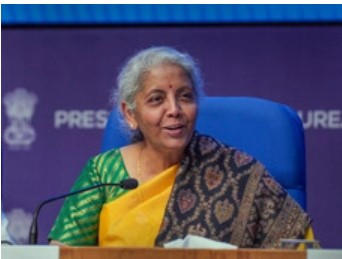The budget has taken advantage of the fiscal space created by the end of the Covid free-food programme, lower fertiliser subsidies, and a sharp reduction in MGNREGA outlay. This has made possible the reduction of ₹37,000 crore in direct taxes. The finance minister wants taxpayers to shift to the new income tax regime which disallows myriad individual exemptions but gives a higher exemption limit of ₹7 lakh, facilitating both taxpayers and collectors. This has an element of election budgeting.
The budget achieves the hat-trick of greatly boosting capital spending, slashing taxes, and reducing the fiscal deficit. The BJP’s love affair with the middle class will deepen with the raising of the tax exemption limit from ₹5 lakh to ₹7 lakh. Yet this is not an election budget full of freebies. The PM-Kisan outlay for farmers remains unchanged in nominal terms and hence lower in real terms. Far from going on a pre-electoral spree, the budget cuts the fiscal deficit from 6.4% to 5.9% of GDP and projects a further fall of 0.7% per year for the next two years. That is exceedingly ambitious and will require excellent global conditions.
Gross tax revenues are projected to rise 10.5%, exactly in line with nominal GDP, so actual revenue could be higher if the recent buoyancy in taxes continues. Yet this well-balanced budget did not cheer stock markets – the Nifty drifted down 0.26%, mainly on account of the continuing debacle in Adani shares.
Capital expenditure is projected to rise a whopping 33%, with Railways (48%) and roads (24.4%) leading the way.
Shift from MGNREGA
Total infrastructure spending will rise by ₹10 lakh crore, with the states getting ₹1.3 lakh crore. The focus will be on 100 projects where ₹75,000 crore of ‘last-mile’ investment will ensure the completion of long-gestation projects. Outlays on the transition to a green economy – in line with climate goals – will be ₹35,000 crore. Effective capex will be a notable 4.5% of GDP, and this should crowd-in private investment to create an investment boom. The balance sheets of both banks and corporations have been mended after a decade of high non-performing assets, so the budget should help spur a private investment boom.
Privatisation efforts have consistently disappointed in recent years, and the budget no longer views this as a major thrust area for revenue. The ambitious Asset Monetisation Pipeline seems to have been given up. Disinvestment receipts are estimated at a modest ₹51,000 crore. This conservative budgeting provides a cushion if unexpected external shocks – which the Economic Survey warned against – hit the economy.
The rural approach has shifted away from MGNREGA. Outlays for the Jal Jeevan Mission for piped water (₹0.7 lakh crore) and the PM Awas Yojana for housing (₹0.8 lakh crore) are higher than for MGNREGA (₹0.6 lakh crore). Clearly, rural housing and drinking water are going to be points the BJP will emphasise in the upcoming state elections.
The budget has taken advantage of the fiscal space created by the end of the Covid free-food programme, lower fertiliser subsidies, and a sharp reduction in MGNREGA outlay. This has made possible the reduction of ₹37,000 crore in direct taxes. The finance minister wants taxpayers to shift to the new income tax regime which disallows myriad individual exemptions but gives a higher exemption limit of ₹7 lakh, facilitating both taxpayers and collectors. This has an element of election budgeting.
One reason for the absence of market enthusiasm for the budget is that the long-term fiscal situation is still a matter of concern. Even the 2025-26 target of 4.5% is way above the original 3% target in the Fiscal Responsibility and Budget Management Act. For sustainability, the primary deficit – that is, the fiscal deficit minus interest payments – should be zero. But it was 3% last year and is projected at 2.3% for 2023-24, still very high by global standards. Covid spending took the fiscal deficit to unprecedented heights and getting that down is still a tough job. This is one reason why foreign investors pulled money out of India in 2022 despite the fact that it was the fastest-growing major economy.
Revenue expenditure is projected to be almost unchanged next year compared with revised estimates for this year. Since interest payments will rise 14% and inflation should be at least 4.5%, perhaps revenue expenditure has been understated. This may erode some fiscal cushions in the budget.
Contrary to government hopes, huge increases in capex in the last two years have not made a significant dent on unemployment, especially for youngsters below 30 years. Infrastructure is inherently capital-intensive, creating some jobs during construction but much less after completion. The green emphasis on renewable energy is highly capital intensive. Solar farms and wind farms yield very few jobs. High government capex should crowd-in private investment that is more labour-intensive. Yet technology is relentlessly killing jobs, not just in India, but globally.
This article was originally published by The Economic Times on Feb 02, 2023


